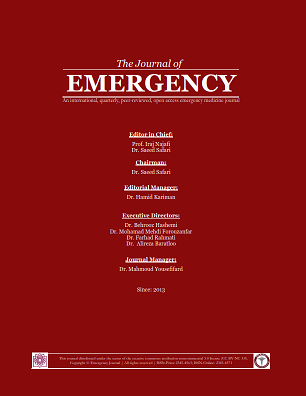Low-Dose Fentanyl, Propofol, Midazolam, Ketamine and Lidocaine Combination vs. Regular Dose Propofol and Fentanyl Combination for Deep Sedation Induction; a Randomized Clinical Trial
EMERGENCY ,
Vol. 6 No. 1 (2018),
19 November 2017
,
Page e57
https://doi.org/10.22037/emergency.v6i1.23065
Abstract
Introduction: Need for procedural sedation and analgesia (PSA) is felt in emergency department (ED) more and more each day. This study aimed to compare the effectiveness of low-dose fentanyl, propofol, midazolam, ketamine and lidocaine combination with regular dose of propofol and fentanyl combination for induction of deep sedation.
Methods: In this single-blind clinical trial, candidate patients for sedation and analgesia aged more than 15 and less than 60 years old, with pain score ≥6 were allocated to one of the groups using block randomization and were compared regarding onset of action, recovery time, and probable side effects.
Results: 125 patients with the mean age of 37.8 ± 14.3 years were randomly allocated to each group. 100% of the patients in group 1 (5 drugs) and 56.5% of the patients in group 2 (2 drugs) were deeply sedated in the 3rd minute after injection. The 2 groups were significantly different regarding onset of action (p = 0.440), recovery time (p = 0.018), and treatment failure (p < 0.001).
Conclusion: Low-dose fentanyl, propofol, midazolam, ketamine and lidocaine combination was more successful in induction of deep sedation compared to regular dose of propofol and fentanyl combination. Recovery time was a little longer in this group and both groups were similar regarding drug side effects and effect on vital signs.
- Clinical trial
- deep sedation
- emergency service
- hospital
- ketamine
- propofol
- analgesia
References
Karceski S, Morrell M, Carpenter D. The expert consensus guideline series: treatment of epilepsy. Epilepsy & Behavior. 2001;2(6):A1-A50.
Group TC. Rapid tranquillisation for agitated patients in emergency psychiatric rooms: a randomised trial of midazolam versus haloperidol plus promethazine. BMJ: British Medical Journal. 2003;327(7417):708-14.
Esmailian M, Moshiri R, Zamani M. Comparison of the Analgesic Effect of Intravenous Acetaminophen and Morphine Sulfate in Rib Fracture; a Randomized Clinical Trial. 2014. 2014;3(3):4.
Faridaalaee G, Rahmani SH, Mehryar H, Bina Shishavan S, Merghati SZ, Valizade Hasanloei MA, et al. Comparison of Intravenous Metoclopramide and Acetaminophen in Primary Headaches: a Randomized Controlled Trial. 2014. 2014;3(2):5.
Alimohammadi H, Shojaee M, Samiei M, Abyari S, Vafaee A, Mirkheshti A. Nerve Stimulator Guided Axillary Block in Painless Reduction of Distal Radius Fractures; a Randomized Clinical Trial. 2013. 2013;1(1):4.
Hoffman GM, Nowakowski R, Troshynski TJ, Berens RJ, Weisman SJ. Risk reduction in pediatric procedural sedation by application of an American Academy of Pediatrics/American Society of Anesthesiologists process model. Pediatrics. 2002;109(2):236-43.
Apfelbaum JL, Silverstein JH, Chung FF, Connis RT, Fillmore RB, Hunt SE, et al. Practice Guidelines for Postanesthetic CareAn Updated Report by the American Society of Anesthesiologists Task Force on Postanesthetic Care. The Journal of the American Society of Anesthesiologists. 2013;118(2):291-307.
Tosun Z, Esmaoglu A, Coruh A. Propofol–ketamine vs propofol–fentanyl combinations for deep sedation and analgesia in pediatric patients undergoing burn dressing changesa. Pediatric Anesthesia. 2008;18(1):43-7.
Tosun Z, Aksu R, Guler G, Esmaoglu A, Akin A, Aslan D, et al. Propofol‐ketamine vs propofol‐fentanyl for sedation during pediatric upper gastrointestinal endoscopy. Pediatric Anesthesia. 2007;17(10):983-8.
Correia LM, Bonilha DQ, Gomes GF, Brito JR, Nakao FS, Lenz L, et al. Sedation during upper GI endoscopy in cirrhotic outpatients: a randomized, controlled trial comparing propofol and fentanyl with midazolam and fentanyl. Gastrointestinal endoscopy. 2011;73(1):45-51. e1.
Sajedi1 PAY, Ahmad%A Bigi2, Ali Akbar%A Rezaie3, Mahin%A Mehrabi Kooshki4, Ali. Comparative Evaluation of Vital Signs Stability, Sedation and Analgesia Scores with Two Methods of Sedation: Propofol+Fentanyl and Ketamine+Fentanyl during Perm Cath Insertion. Research in Medicine. 2010;34(1):13-9.
Aydin Erden I, Gulsun Pamuk A, Akinci SB, Koseoglu A, Aypar U. Comparison of propofol‐fentanyl with propofol‐fentanyl‐ketamine combination in pediatric patients undergoing interventional radiology procedures. Pediatric Anesthesia. 2009;19(5):500-6.
Akin A, Guler G, Esmaoglu A, Bedirli N, Boyaci A. A comparison of fentanyl-propofol with a ketamine-propofol combination for sedation during endometrial biopsy. Journal of clinical anesthesia. 2005;17(3):187-90.
Treston G, Bell A, Cardwell R, Fincher G, Chand D, Cashion G. What is the nature of the emergence phenomenon when using intravenous or intramuscular ketamine for paediatric procedural sedation? Emergency medicine Australasia : EMA. 2009;21(4):315-22.
- Abstract Viewed: 572 times
- PDF Downloaded: 366 times
